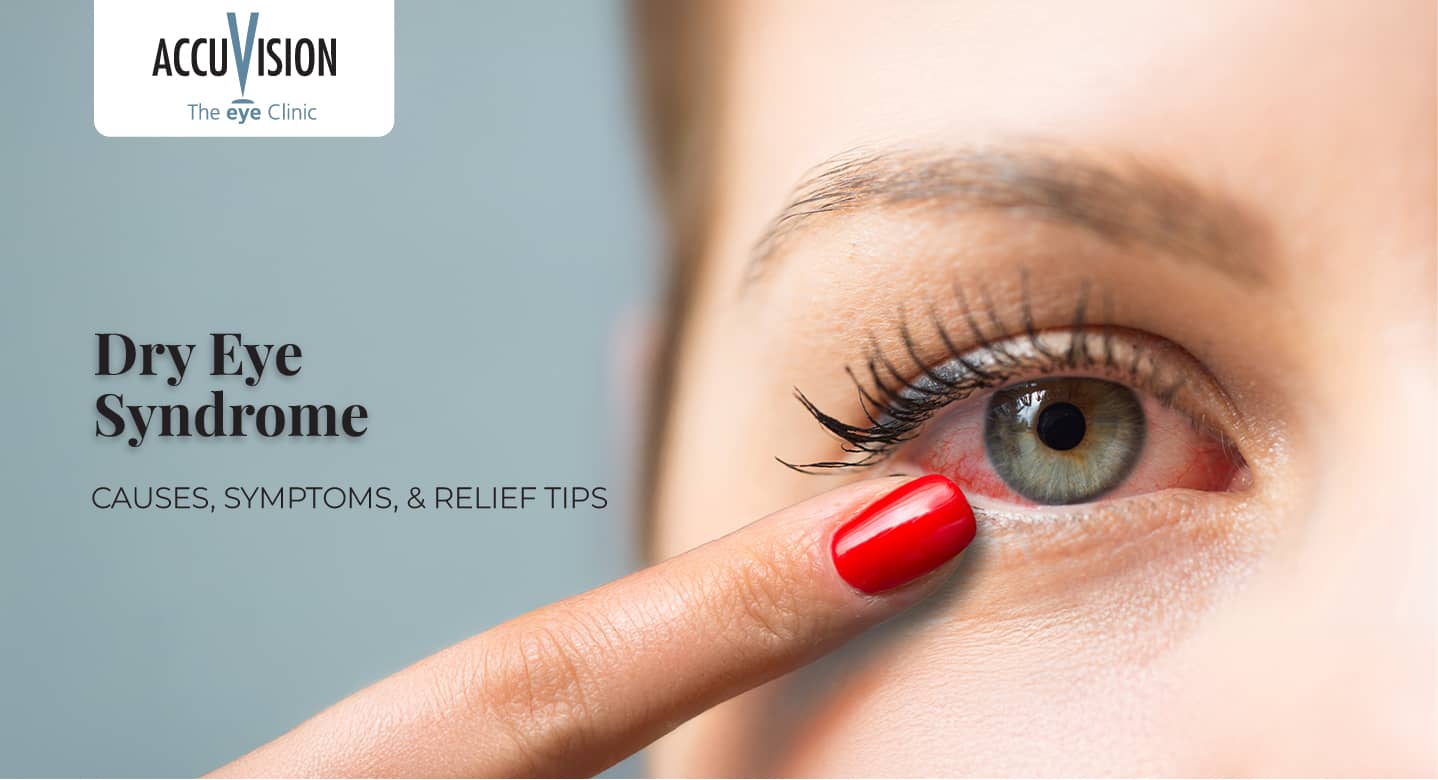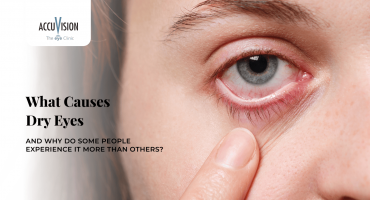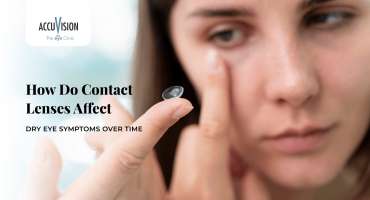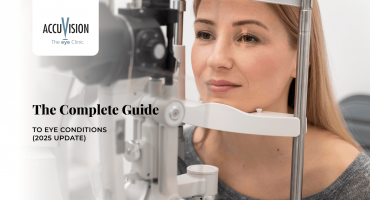- Understanding Dry Eye Syndrome
- Common Causes of Dry Eye Syndrome
- Symptoms to Watch Out For
- Relief Tips and Management Options
- Is Dry Eye Syndrome Permanent?
- When to Seek Professional Help
- Conclusion
- Frequently Asked Questions
Dry Eye : Causes, Symptoms, and Relief Tips

Dry eye syndrome is a common condition in which the eyes either do not produce enough tears or the tears evaporate too quickly, leading to ocular surface problems including dryness, irritation, and discomfort. This seemingly simple problem can significantly impact daily activities, making it difficult to:
- Work productively at a computer screen
- Drive safely, especially at night
- Read books or newspapers comfortably
- Enjoy outdoor activities without discomfort
A study using TFOS DEWS II criteria found that approximately one-third of the adult UK population experiences dry eye disease. Cases are increasing due to our digital lifestyle and environmental factors such as central heating and air conditioning. Many people worry: “Is dry eye syndrome permanent?” The good news is that while some cases can be chronic, most can be effectively managed with the right approach, allowing you to maintain comfort and day-to-day quality of life.
Understanding Dry Eye Syndrome
A continuous layer of tears is essential to keep your eyes nourished, protected, and comfortable. When this system fails, it results in dry eye syndrome. This happens in two main ways:
- Insufficient tear production: Your tear glands don’t make enough tears.
- Poor tear quality: Tears evaporate too quickly or don’t spread evenly.
Dry eye syndrome can be categorised into two types:
- Temporary dry eye: Commonly linked to environmental triggers, certain medications, or short-term health conditions.
- Chronic dry eye: Long-term condition requiring ongoing management.
The common causes of dry eye syndrome vary widely, but understanding whether your condition is temporary or chronic and the underlying causes helps determine the best treatment approach. Most importantly, even chronic cases can be managed effectively with proper care, meaning you don’t have to accept persistent discomfort as inevitable.
Common Causes of Dry Eye Syndrome
Understanding the common causes of dry eye syndrome helps identify triggers and develop effective management strategies:
1. Age-Related Factors:
- Natural decline in tear production after age 50.
- Hormonal changes including during menopause.
- General ageing of the eye’s tear-producing glands.
2. Environmental Factors:
- Air conditioning and central heating systems.
- Wind and dry weather conditions.
- Pollution and smoke exposure.
- Low humidity environments.
3. Medical Conditions:
- Autoimmune disorders (rheumatoid arthritis, Sjögren’s syndrome).
- Diabetes and thyroid conditions.
- Allergies and skin conditions around the eyes.
4. Medications:
- Antihistamines for allergies.
- Antidepressants and anxiety medications.
- Blood pressure medications.
- Hormone replacement therapy.
5. Digital Lifestyle:
- Extended computer and smartphone use reduces natural blinking.
- Blue light exposure from screens might increase the prevalence.
- Poor workstation ergonomics leading to eye strain.
According to the Association of Optometrists (UK), signs of dry eye can develop in as little as 20 minutes of using digital devices. This digital connection is crucial for dry eyes from computer use relief, as many UK workers now spend long hours daily looking at screens, significantly reducing their blink rate and increasing tear evaporation.
Symptoms to Watch Out For
Recognising dry eye symptoms early helps ensure timely treatment and lowers the risk of the condition worsening. Common signs include:
1. Physical Sensations:
- Gritty, scratchy or sandy, foreign body feeling in the eyes.
- Burning or stinging sensations.
- Feeling like something is stuck in your eye.
2. Vision-Related Symptoms:
- Blurred vision that improves with blinking.
- Eye fatigue, especially after screen use.
- Difficulty focusing on detailed tasks.
3. Unexpected Symptoms:
- Watery eyes.
- Light sensitivity, particularly to bright lights.
- Redness and inflammation around the eyes.
Important: While these symptoms are common, proper diagnosis requires professional evaluation. In the UK, start with your local Optometrist, who can refer you to an Ophthalmologist if specialist care is needed.
Relief Tips and Management Options
a) Lifestyle and Natural Remedies
Learning how to relieve dry eyes naturally at home involves simple but effective strategies:
1. Environmental Modifications:
- Use a humidifier to raise indoor humidity and avoid dry air.
- Position yourself away from direct air currents.
- Take regular breaks from air-conditioned rooms.
- Wear wraparound sunglasses outdoors to reduce wind exposure.
2. Daily Care Routines:
- Apply warm compresses for 10-15 minutes twice daily.
- Practice gentle eyelid massage after warm compresses.
- Maintain good eyelid hygiene with gentle cleaning.
- Ensure adequate sleep of 7-8 hours for natural tear production.
- Stay well-hydrated throughout the day.
3. Nutritional Support – Foods that Help with Dry Eyes:
- Leafy greens: Spinach, kale, and other vegetables high in lutein.
- Vitamin A sources: Carrots, sweet potatoes, liver, dairy products.
- Anti-inflammatory foods: Berries, turmeric, green tea.
Foods that help with dry eyes work by reducing inflammation and supporting healthy tear production, though dietary changes should complement other treatments.
b) Screen-Related Relief Tips
For relief from computer-related dry eyes, try implementing these workplace strategies:
1. The 20-20-20 Rule:
- Every 20 minutes, look at something 20 feet away for 20 seconds.
- Set regular reminders on your computer or phone.
- Use this time to blink deliberately and fully.
2. Screen Setup Optimisation:
- Position your screen 20-26 inches from your eyes.
- Ensure the top of your screen is at or below eye level.
- Adjust brightness to match your surrounding environment.
- Increase text size to reduce eye strain.
- Use dark mode when available to reduce glare.
c) Medical and Over-the-Counter Support
Artificial Tears and Lubricating Drops:
When searching for the best eye drops for dry eyes, UK patients will find many options in pharmacies nationwide. Choosing the right one depends on your specific symptoms and tear film type. Key points to consider include:
- Preservative-free options: Better for frequent use and sensitive eyes.
- Viscosity levels: Thinner drops for mild symptoms, thicker gels for severe dryness. Sometimes a combination of different types of lubricants may be recommended by your practitioner.
- Specific formulations: Some target oil layer deficiency, others focus on water retention.
The best eye drops for dry eyes UK market offers various options available at pharmacies nationwide, but choosing the right one depends on your specific symptoms and tear film type.
When to Consider Prescription Treatments:
If your symptoms persist despite regular use of over-the-counter drops, an Optometrist or Ophthalmologist may recommend prescription treatments. These can include:
- Anti-inflammatory eye drops prescribed under specialist care.
- Short courses of steroid drops, used cautiously under medical supervision.
- Punctal plugs, which help retain tears by reducing drainage.
Is Dry Eye Syndrome Permanent?
The question “Is dry eye syndrome permanent?” concerns many sufferers, but the answer offers hope.
In many cases, dry eyes are temporary. Environmental or medication-induced symptoms often resolve once the trigger is removed. Hormonal changes may also improve over time, and digital eye strain typically responds well to simple lifestyle modifications.
For some people, dry eyes can be chronic. While it may be long-lasting, symptoms can usually be reduced significantly with the right care. Ongoing management helps prevent the condition from worsening, and many people achieve comfortable vision with appropriate treatment. Encouragingly, new therapies continue to emerge, providing even more options for relief.
The key point is that even when dry eye syndrome is chronic, it is highly manageable rather than something you must simply endure. Early intervention and consistent care almost always lead to better outcomes.
When to Seek Professional Help
Don’t delay professional consultation if you experience:
1. Persistent Symptoms:
- Dry eye symptoms lasting more than a few weeks.
- Worsening discomfort despite home treatments.
- Symptoms interfering with work or daily activities.
2. Vision Concerns:
- Blurred vision that doesn’t improve with blinking.
- Significant light sensitivity.
- Eye pain rather than just discomfort.
UK Healthcare Pathway:
- Start with your local Optometrist for a comprehensive eye examination.
- GP consultation for medication reviews and underlying condition assessment.
- Ophthalmologist referral for complex cases requiring specialist treatment.
Early professional intervention prevents complications and ensures you receive appropriate treatment for your specific type of dry eye.
Conclusion
Dry eye syndrome affects millions across the UK, but it’s a highly manageable condition rather than something you must accept as inevitable. Small lifestyle changes, proper eye care routines, and professional guidance when needed can dramatically improve your comfort and quality of life.
Whether you’re dealing with dry eyes from computer use or wondering, “is dry eye syndrome permanent?”, remember that effective solutions exist. Taking proactive steps to protect your eye health is a valuable investment in your long-term wellbeing and daily comfort.
Frequently Asked Questions
1. Can I buy effective eye drops for dry eyes in the UK without a prescription?
Yes. Preservative-free artificial tears and gels are widely available in UK pharmacies. Your Optometrist can guide you to the most suitable option.
2. How long should I try home remedies before seeing an eye specialist in the UK?
If symptoms last more than 2–3 weeks or interfere with daily tasks, see your optometrist for an eye check.
3. Can diet really help with dry eye symptoms?
Yes. Vitamin A, and antioxidants in foods like salmon, flaxseeds, spinach, and carrots can support eye health.
4. Is dry eye syndrome linked to screen use at work in the UK?
Yes. The Association of Optometrists notes symptoms can appear after just 20 minutes of screen use, especially with long daily exposure.
5. Is dry eye syndrome permanent?
Not always. Many cases are temporary, and even chronic dry eye can usually be managed effectively with the right treatment.
References:
Vidal-Rohr, M., Craig, J. P., Davies, L. N. & Wolffsohn, J. S. (2023) ‘The epidemiology of dry eye disease in the UK: The Aston dry eye study’, Contact Lens & Anterior Eye, 46(3), 101837. Published online 30 March. doi: 10.1016/j.clae.2023.101837.
Bulpin, C. (2024) ‘Screentime eyes: talking to screen-based workers about dry eye and (dis)comfort’, Optometry Today, 23 June. Available at: AOP website (Accessed: 26/05/25).








